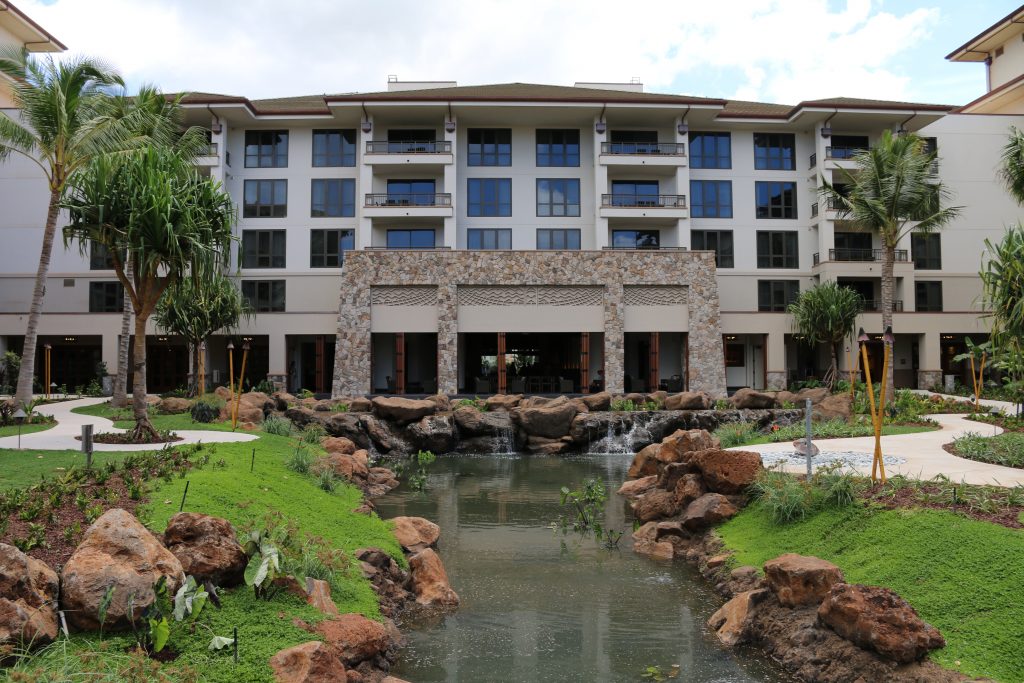Maui Timeshare Properties Average 90.8% Occupancy in 3Q 2017
Timeshare properties in Hawaiʻi continued to demonstrate their importance to the state’s lodging portfolio in the third quarter of 2017, averaging a 90.1% occupancy rate statewide. By comparison, hotel properties averaged an 81.4% occupancy rate for the quarter.
The data was part of the Hawaiʻi Timeshare Quarterly Report for the third quarter released today by the Hawaiʻi Tourism Authority.

The Westin Nanea Ocean Villas. PC: Nikki Schenfeld, The increase in timeshare accommodations included the openings of the 411-unit Hilton Grand Islander in Waikiki last March and the 195-unit Westin Nanea Ocean Villas on Maui last April.
The report shows that timeshare accommodations grew by 725 units to 11,233 units statewide compared to a year ago. The increase in timeshare accommodations included the openings of the 411-unit Hilton Grand Islander in Waikiki last March and the 195-unit Westin Nanea Ocean Villas on Maui last April.
Timeshare occupied room nights statewide increased by 4% in the third quarter year-over-year. However, with the supply of available timeshare units also increasing by 5.8% during the same period, the overall occupancy rate statewide declined slightly by 1.5 percentage points in the third quarter compared to a year earlier.
Owners of Hawaiʻi timeshare units accounted for 56.9% of occupied room nights in the third quarter, while exchangers (timeshare owners participating in a timeshare exchange program) took up 19.9% of the occupied room nights. Transient rental of units to owners and exchangers beyond their allotted timeshare stay, as well as to the general public, represented 15.5% of occupied room nights. The remaining balance, 7.7%, was used for sales and marketing purposes.
Jennifer Chun, HTA Director of Tourism Research, noted timeshare properties are essential to Hawaiʻi’s mix of accommodations offerings. “With so much public dialogue about Hawaiʻi lodging focused on hotels and alternative accommodations, the impact of timeshare properties tends to get overlooked. Timeshare visitors consistently fill up resort properties on a year-round basis, their average stay is longer than other visitors, and owners pay more in taxes.
“Hawaiʻi is one of the few destinations worldwide that considers timeshare properties to be a traditional accommodation. Timeshare has a major influence on tourism’s overall success and Hawaiʻi’s ability to attract repeat visitors who commit to spend their time and money annually in the islands. Moreover, timeshare’s appeal continues to expand beyond visitors from North America. Timeshare usage by visitors from Japan has increased significantly in recent years. All of this helps to stabilize Hawaiʻi’s tourism industry.”
HTA’s timeshare report showed that 235,112 visitors stayed at a timeshare resort in the Hawaiian Islands for all or part of their stay during the third quarter, an increase of 7.6% year-over-year. Of that total, 182,356 visitors, or 77.6%, stayed exclusively at a timeshare resort, with the remaining 52,756 visitors, or 22.4%, extending their visit in Hawaiʻi with other lodging arrangements. Altogether, timeshare visitors represented 9.8% of total visitors to Hawaiʻi in the third quarter.
Timeshare visitors’ average length of stay in the Hawaiian Islands during the third quarter was 9.7 days, which was higher than the average length of stay of 8.8 days for all visitors.
The average timeshare occupancy rate for all four island counties dipped slightly in the third quarter year-over-year. Oʻahu timeshare occupancy averaged 92.5% (-1.7%), Maui County timeshare occupancy averaged 90.8% (-1.7%), Kauaʻi timeshare occupancy averaged 89.4% (-1.1%), and the island of Hawaiʻi timeshare occupancy averaged 84.6% (-2.7%).
The decline in third quarter occupancy was partly due to new timeshare units opening in early 2017, as the supply of available timeshare units outpaced demand. This is reflected in the accompanying bar chart showing the timeshare occupancy rate for the state and by island through the first three quarters.
The average timeshare occupancy rate for the four island counties was at its highest in the first quarter of 2017, with statewide at 92.6%, Oʻahu at 92.7%, Maui at 94.1%, Kauaʻi at 91.5%, and the island of Hawaiʻi at 91.1%.
With an influx of new timeshare units entering the marketplace, particularly in March and April of 2017, the average occupancy rate dropped in the second quarter, with statewide at 88.2%, Oʻahu at 90.8%, Maui at 92% and both Kauaʻi and the island of Hawaiʻi at 83% each.
Timeshare properties participating in the survey for the Hawaiʻi Timeshare Quarterly Report generated a total of $23.0 million in state and county taxes in the third quarter, including real property tax, general excise tax, timeshare occupancy tax, transient accommodations tax and conveyance tax. Real property tax accounted for the largest share of taxes paid by timeshare owners at $10.9 million, or 47.3%, of the total amount.
Statewide payroll expenses totaled $79.5 million, as reported by timeshare survey participants.
HTA’s Hawaiʻi Timeshare Quarterly Report was prepared by Kloninger & Sims Consulting LLC. The timeshare survey findings for the third quarter are based on data provided by 51 individual timeshare properties representing 82.8% of Hawaiʻi’s 11,233 timeshare units statewide.










